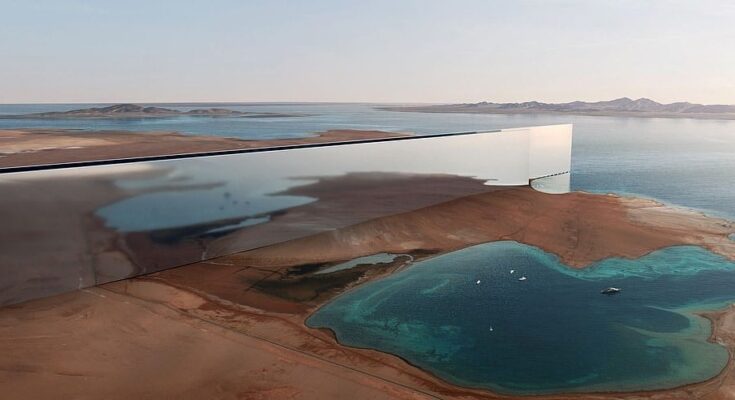Saudi Arabia started the construction of a 75-mile-long skyscraper called the Mirror Line that will stretch across its desert, housing up to five million people. It is projected to cost a whopping $1 trillion.
The state-of-the-art skyscraper will be taller than the Empire State Building, made of mirrored glass, and a part of the desert city called the Neom that will be around the size of Massachusetts.
The city called the Neom was announced in January 2021 by Saudi Crown Prince Mohammed bin Salman after saying he wanted his country to house a construction project as iconic and timeless as the Pyramids of Egypt.
At that time, Prince Muhammed said, “The Line is a project that is a civilizational revolution that puts humans first,” claiming he wants the Mirror Line to be ready by 2030 although engineers have said it could take fifty years to construct.
He further said the project would allow a million residents to meet within a five-minute walk and travel end-to-end within a twenty-minute stretch. It will also reportedly be powered by renewable energy.
A deeper insight into the Mirror Line desert skyscraper
The Mirror Line skyscraper will consist of two 1,600-foot tall buildings that run parallel to each other across 75 miles of desert, coastal, and mountain landscapes with a high-speed train running underneath the length of the buildings.
The building is so long that it will sit on struts to take the curvature of the Earth into account. There will also be a marina for boats.
The futuristic buildings feature a silver shine and an intricate inside with stairwells, greenery, and homes to create a linear community that will be fed through vertical farming integrated into its walls. Residents will reportedly pay a subscription for three meals a day.
Prince Muhammed mentioned that living in the desert won’t just be hot, sticky, and sandy, but the Mirror Line will also feature a sports stadium set to be a thousand feet above the ground. The buildings are expected to be totally carbon neutral and sustainable for the local environment.
Planners of the skyscraper are struggling to predict, first of all, if residents would consider living in a high-rise building after the pandemic. Furthermore, the most efficient method for dealing with the structure impacting the migration of animals and birds and the flow of groundwater also needs to be determined.
Environmental planners say the sheer size and length of the Mirror Line will disrupt migratory bird patterns, and the mirrored glazing of the building could further confuse them, conflicting with the project’s supposed eco-friendliness.
The global perspective on the $1 trillion desert skyscraper
The Mirror Line project was originally set to be completed in fifty years; however, its completion date is set for 2030, but builders and urban planners are struggling to resolve many questions and controversies.
Foreign investments in the Neom have not been so forthcoming, as many Western countries continue to boycott the country over alleged human rights violations.
Prince Salman has been accused of ordering the killing of journalist Jamal Khashoggi in 2018, but the Crown Prince has denied any involvement. The project also faced human rights criticism when it was announced that tribes were forcefully removed from the area and security allegedly shot a resident dead.
Others who have fewer political scruples have questioned whether the projects devised are too ambitious. Saudi Arabia previously abandoned plans to build a mile-high desert skyscraper that would have been the world’s tallest after getting into funding difficulties.
The Wall Street Journal said that high oil prices are actually helping Salman continue with the Mirror Line and Neom, as it is providing funding for the expensive project.
Prince Salman also hopes the project will create thousands of new jobs and allow the oil-rich country to stop being so dependent on the resource for wealth, according to The Wall Street Journal.
If completed, the skyscraper will run from the Gulf of Aqaba through a mountain range and then extend along the coast into a desert ‘aerotropolis.’



